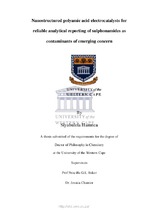| dc.description.abstract | Polyamic acid (PAA) nanostructured materials were successfully produced by electrochemical deposition and electrospinning using polyvinlypyrrolidone (PVP) as supporting polymer. Polyamic acid thin film and nanofibers were deposited directly at the surface of a screen-printed carbon electrode (SPCE) as electro-catalysts for reliable analytical reporting of sulphonamide as contaminants of emerging concern by electrochemical techniques. Fourier transform infrared (FTIR) spectroscopy was used to confirm the structural integrity of the PAA electrospun nanofibers compared to the chemical synthesized PAA. Brunauer-Emmett-Teller (BET) was used to determine the surface area of the nanofibers. The surface morphology and surface thickness of the polyamic acid (PAA) nanofibers on the screen-printed electrodes was studied using scanning electron microscopy (SEM) and atomic force microscopy (AFM). Cyclic voltammetry (CV) was used to study redox behavior of the nanostructured PAA modified screen-printed carbon electrodes. Electrochemical parameters surface concentration, diffusion coefficient, formal potential and peak separation were determined. Three sulphonamides were selected based on the United States of protection agency (US EPA) and World Health Organization (WHO) list of emerging contaminants and detected sulphonamides in environmental waters in South Africa and other African regions. The selected sulfonamides were evaluated at the unmodified and modified screen-printed carbon electrodes. The sulphonamides were evaluated in three different supporting electrolytes at pH < 7 and >7 to enhance electrochemical signal reporting. Sulfadiazine (SDZ), sulfamethoxazole (SMX) and sulfamethazine (SMZ) displayed peaks at 0.80 V vs Ag/AgCl in 0.1 M tris-HCl using square wave voltammetry at the unmodified transducer. At the PAA thin film transducer, SDZ, SMX and SMZ displayed well-defined analytical oxidative peaks at 0.77 V 0.82 V and 0.83 V vs Ag/AgCl respectively. The LOD (n=3) for SDZ was found to be 12.14 ųM with a correlation coefficient of 0.9950. The LOD (n=3) for SMX and SMZ was found to 14.59 ųM (R2 =0.9928) and 10.41 ųM (R2 =0.9963). These sulphonamides were also electro-analytical evaluated at the screen-printed carbon PAA nanofiber modified transducer. SDZ, SMX and SMZ produced well-defined analytical signals at 0.79 V, 0.81 V and 0.78 V vs Ag/AgCl respectively. The determined LOD (n=3) for the individual sulphonamides was 8.26 ųM, 16.59 ųM and 8.81 ųM SDZ, SMX and SMZ respectively. The linearity correlation coefficient (R2) was determined to be 0.9977, 0.9956 and 0.9974 respectively. The efficacy of the proposed nanostructured PAA thin film modified screen-printed carbon sensor was evaluated by performing recovery studies for the selected sulphonamides using square wave voltammetry. Tap water was used to simulate environmental matrix. The recoveries of SDZ with respect to each concentration were 98.84% (RSD 4.98%) to 40.58% (RSD 6.74%). For SMX the recoveries were 154.17% (RSD 11.00%) to 111.03% (RSD 16.80%). The recoveries for SMZ with respect to each concentration were 184% (RSD 8.19%) to 90.26 (RSD 18.26%) indicating the reliability of the analytical results. | en_US |

